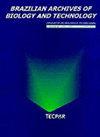Oral Yeast Load and Species of Young Individuals Aged 18-25
IF 1.1
4区 生物学
Q3 BIOLOGY
引用次数: 0
Abstract
: Microbiota is considered an organ that affects the health of the human body and includes many microorganisms such as bacteria, yeast, mold, viruses, protozoa, and archaea. Microorganism such as Candida sp., a part of the microbiota, is known to cause diseases in the case of opportunistic pathogens under various conditions. Yeast loads and species in the oral mycobiota of young individuals aged 18-25 were determined in our study. Two methods, centrifugation and dilution, were used to determine the oral yeast load. Samples were taken from 31 individuals for the centrifugation method, including 29 for the dilution method and five of these individuals. The samples were inoculated on Sabouraud 2% Dextrose Agar (SDA) and SDA containing chloramphenicol (SCAF). As a result, in young individuals aged 18-25, the oral yeast load was 0.01±0.01 and 1.87±0.01 log CFU in SCAF, and it was 0.01±0.01 and >3.00±0.01 log CFU in SDA. A total of 400 isolates were taken from the counting plates, and 140 were determined to be yeast by gram staining. Germ tube test of the isolates determined to be yeasts determined that 108 were probably Candida albicans or Candida dubliniensis . 140 isolates were also identified by MALDI-TOF MS. Isolates were identified as C. albicans (38.58%), C. albicans or C. africana (3.57%), C. dubliniensis (32.86%), C. parapsilosis (20%), C. inconspicua (2.14%), Pichia manshurica (2.14%), and Wickerhamomyces subpelliculosus (0.71%). It has been determined that young individuals between the ages of 18-25 carry Candida species in their oral mycobiota.18-25岁青年口腔酵母菌量及种类
本文章由计算机程序翻译,如有差异,请以英文原文为准。
求助全文
约1分钟内获得全文
求助全文
来源期刊
CiteScore
1.80
自引率
0.00%
发文量
116
审稿时长
3 months
期刊介绍:
Information not localized

 求助内容:
求助内容: 应助结果提醒方式:
应助结果提醒方式:


